Entrepreneurship and Small Business: Ventures and UK Economy Impact
VerifiedAdded on 2024/05/17
|24
|5235
|191
Report
AI Summary
This report provides a comprehensive overview of entrepreneurship and small business management, focusing on different types of entrepreneurial ventures such as small businesses, lifestyle businesses, social good businesses, and large businesses, and their relationship with the typology of entrepreneurship. It investigates the impact of micro and small businesses on the economy, particularly in the UK, and highlights the importance of small businesses and start-ups in the growth of the social economy. The report also examines the characteristics, traits, and skills of successful entrepreneurs, how their personalities reflect entrepreneurial motivation and mindset, and how their backgrounds and experiences can either hinder or foster entrepreneurship. Using 'Shepper' as an example, the report underscores the role of small businesses in creating job opportunities, fostering competitiveness, and driving innovation, ultimately contributing to the economic development of the country. The document emphasizes the differences between public and private sector entrepreneurship, providing an understanding of how each contributes to the overall economy.

ENTREPRENEURSHIP AND SMALL BUSINESS MANAGEMENT
Paraphrase This Document
Need a fresh take? Get an instant paraphrase of this document with our AI Paraphraser

Contents
INTRODUCTION.....................................................................................................................................2
COMPANY OVERVIEW...........................................................................................................................3
TASK 1....................................................................................................................................................4
P1 DIFFERENT TYPES OF ENTREPRENEURIAL VENTURES AND THEIR RELATION WITH THE
TYPOLOGY OF ENTREPRENEUSHIP.....................................................................................................4
P2 SIMILARITIES AND DIFFERENCES BETWEEN ENTREPRENEURIAL VENTURES................................6
M1 INVESTIGATION OF DIVERSE RANGE OF ENTREPRENEURIAL VENTURES TO UNDERSTAND
ENTREPRENEURSHIP IN PUBLIC AND PRIVATE SECTOR.....................................................................8
P3 IMPACT OF MICRO AND SMALL BUSINESS ON THE ECONOMY....................................................9
P4 THE IMPORTANCE THAT SMALL BUSINESSES AND BUSINESS START-UPS HAS ON THE GROWTH
OF THE SOCIAL ECONOMY...............................................................................................................10
M2 EVALUATION OF THE DIFFERENCE THAT SMALL, MEDIUM AND LARGE BUSINESSES MAKE TO
THE ECONOMY................................................................................................................................11
TASK 2..................................................................................................................................................13
P5 THE CHARACTERISTICS TRAITS AND SKILLS OF SUCCESSFUL ENTREPRENEURS..........................13
P6 HOW ASPECTS OF ENTREPRENEURIAL PERSONALITY REFLECT ENTREPRENEURIAL MOTIVATION
AND MINDSET..................................................................................................................................15
M3 DIFFERENT LINES OF ARGUMENTS RELATING TO ENTREPRENEURIAL CHARACTERISTICS.........17
P7 HOW THE BACKGROUND AND EXPERIENCES CAN HINDER OF FOSTER ENTREPRENEURSHIP....19
M4 LINK BETWEEN ENTREPRENEURIAL CHARACTERISTICS AND THE INFLUENCE OF PERSONAL
BACKGROUND AND EXPERIENCES TO SUCCESSFUL ENTREPRENEURS............................................20
CONCLUSION.......................................................................................................................................21
REFERENCE..........................................................................................................................................22
1
INTRODUCTION.....................................................................................................................................2
COMPANY OVERVIEW...........................................................................................................................3
TASK 1....................................................................................................................................................4
P1 DIFFERENT TYPES OF ENTREPRENEURIAL VENTURES AND THEIR RELATION WITH THE
TYPOLOGY OF ENTREPRENEUSHIP.....................................................................................................4
P2 SIMILARITIES AND DIFFERENCES BETWEEN ENTREPRENEURIAL VENTURES................................6
M1 INVESTIGATION OF DIVERSE RANGE OF ENTREPRENEURIAL VENTURES TO UNDERSTAND
ENTREPRENEURSHIP IN PUBLIC AND PRIVATE SECTOR.....................................................................8
P3 IMPACT OF MICRO AND SMALL BUSINESS ON THE ECONOMY....................................................9
P4 THE IMPORTANCE THAT SMALL BUSINESSES AND BUSINESS START-UPS HAS ON THE GROWTH
OF THE SOCIAL ECONOMY...............................................................................................................10
M2 EVALUATION OF THE DIFFERENCE THAT SMALL, MEDIUM AND LARGE BUSINESSES MAKE TO
THE ECONOMY................................................................................................................................11
TASK 2..................................................................................................................................................13
P5 THE CHARACTERISTICS TRAITS AND SKILLS OF SUCCESSFUL ENTREPRENEURS..........................13
P6 HOW ASPECTS OF ENTREPRENEURIAL PERSONALITY REFLECT ENTREPRENEURIAL MOTIVATION
AND MINDSET..................................................................................................................................15
M3 DIFFERENT LINES OF ARGUMENTS RELATING TO ENTREPRENEURIAL CHARACTERISTICS.........17
P7 HOW THE BACKGROUND AND EXPERIENCES CAN HINDER OF FOSTER ENTREPRENEURSHIP....19
M4 LINK BETWEEN ENTREPRENEURIAL CHARACTERISTICS AND THE INFLUENCE OF PERSONAL
BACKGROUND AND EXPERIENCES TO SUCCESSFUL ENTREPRENEURS............................................20
CONCLUSION.......................................................................................................................................21
REFERENCE..........................................................................................................................................22
1
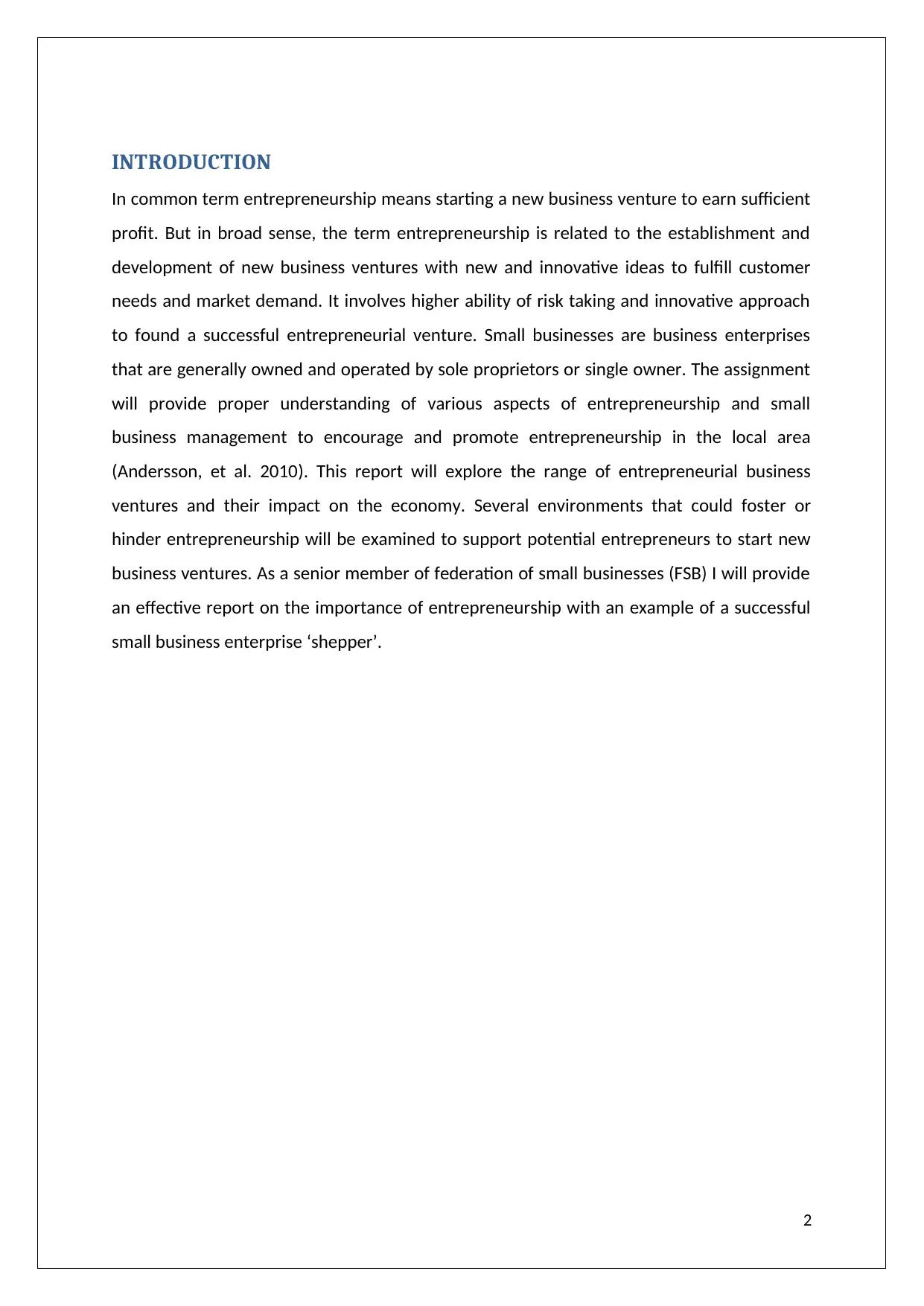
INTRODUCTION
In common term entrepreneurship means starting a new business venture to earn sufficient
profit. But in broad sense, the term entrepreneurship is related to the establishment and
development of new business ventures with new and innovative ideas to fulfill customer
needs and market demand. It involves higher ability of risk taking and innovative approach
to found a successful entrepreneurial venture. Small businesses are business enterprises
that are generally owned and operated by sole proprietors or single owner. The assignment
will provide proper understanding of various aspects of entrepreneurship and small
business management to encourage and promote entrepreneurship in the local area
(Andersson, et al. 2010). This report will explore the range of entrepreneurial business
ventures and their impact on the economy. Several environments that could foster or
hinder entrepreneurship will be examined to support potential entrepreneurs to start new
business ventures. As a senior member of federation of small businesses (FSB) I will provide
an effective report on the importance of entrepreneurship with an example of a successful
small business enterprise ‘shepper’.
2
In common term entrepreneurship means starting a new business venture to earn sufficient
profit. But in broad sense, the term entrepreneurship is related to the establishment and
development of new business ventures with new and innovative ideas to fulfill customer
needs and market demand. It involves higher ability of risk taking and innovative approach
to found a successful entrepreneurial venture. Small businesses are business enterprises
that are generally owned and operated by sole proprietors or single owner. The assignment
will provide proper understanding of various aspects of entrepreneurship and small
business management to encourage and promote entrepreneurship in the local area
(Andersson, et al. 2010). This report will explore the range of entrepreneurial business
ventures and their impact on the economy. Several environments that could foster or
hinder entrepreneurship will be examined to support potential entrepreneurs to start new
business ventures. As a senior member of federation of small businesses (FSB) I will provide
an effective report on the importance of entrepreneurship with an example of a successful
small business enterprise ‘shepper’.
2
⊘ This is a preview!⊘
Do you want full access?
Subscribe today to unlock all pages.

Trusted by 1+ million students worldwide

COMPANY OVERVIEW
SHEPPER is a new small enterprise established in October, 2016. It is founded by Ben Prouty
and Jan Vanhoutte. It is an on demand inspection company. The main business aim of the
company is to offers an effective and low cost security services through visual checks for
valued assets of general people in the UK to provide peace of mind to the owners. It
protects the most viable assets of the users such as cars, boats, warehouses, shops, houses
and other valuable asstes of the customers. The company provides all of these services at a
very affordable price to facilitate general people and gain growth for the organization.
3
SHEPPER is a new small enterprise established in October, 2016. It is founded by Ben Prouty
and Jan Vanhoutte. It is an on demand inspection company. The main business aim of the
company is to offers an effective and low cost security services through visual checks for
valued assets of general people in the UK to provide peace of mind to the owners. It
protects the most viable assets of the users such as cars, boats, warehouses, shops, houses
and other valuable asstes of the customers. The company provides all of these services at a
very affordable price to facilitate general people and gain growth for the organization.
3
Paraphrase This Document
Need a fresh take? Get an instant paraphrase of this document with our AI Paraphraser
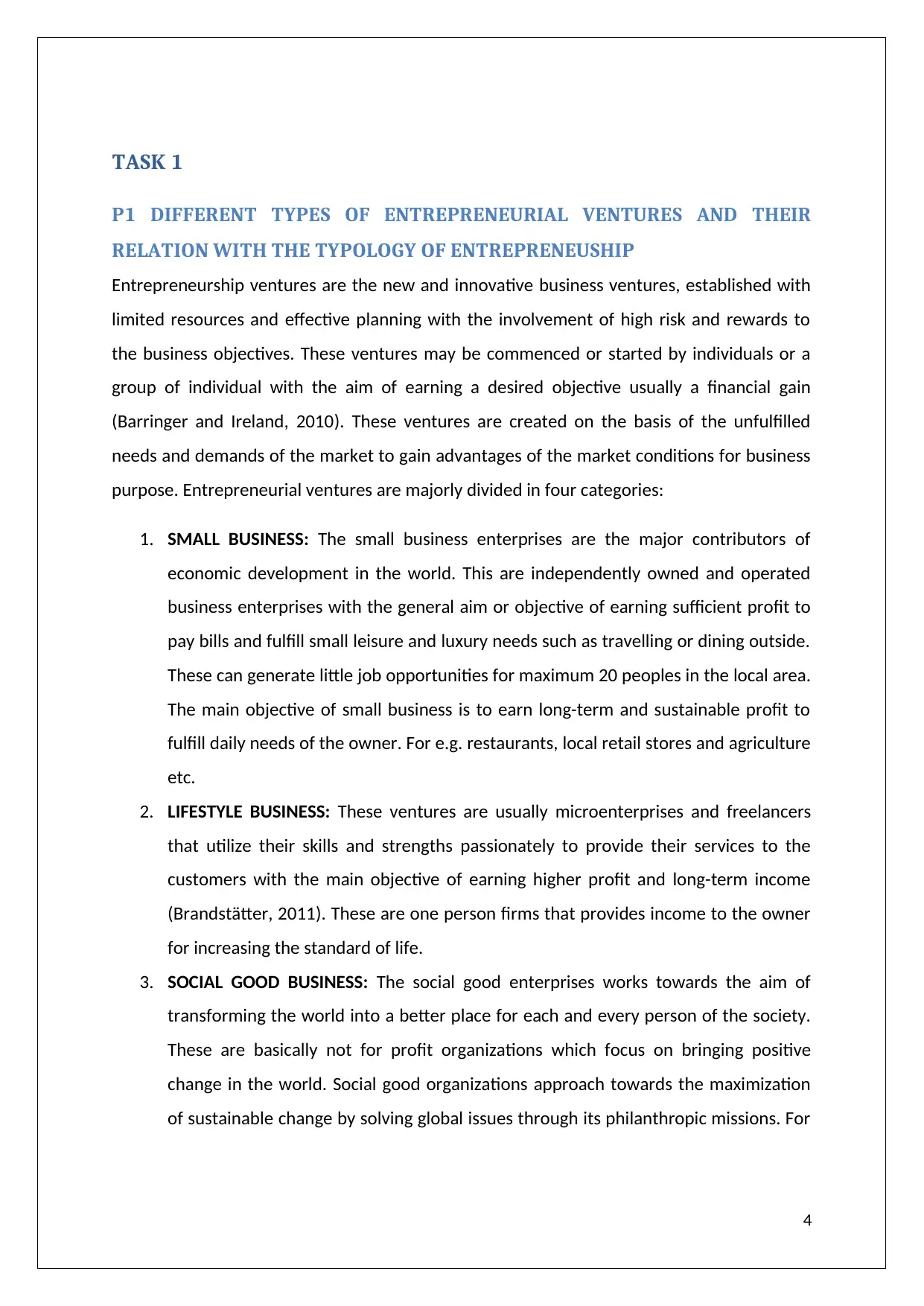
TASK 1
P1 DIFFERENT TYPES OF ENTREPRENEURIAL VENTURES AND THEIR
RELATION WITH THE TYPOLOGY OF ENTREPRENEUSHIP
Entrepreneurship ventures are the new and innovative business ventures, established with
limited resources and effective planning with the involvement of high risk and rewards to
the business objectives. These ventures may be commenced or started by individuals or a
group of individual with the aim of earning a desired objective usually a financial gain
(Barringer and Ireland, 2010). These ventures are created on the basis of the unfulfilled
needs and demands of the market to gain advantages of the market conditions for business
purpose. Entrepreneurial ventures are majorly divided in four categories:
1. SMALL BUSINESS: The small business enterprises are the major contributors of
economic development in the world. This are independently owned and operated
business enterprises with the general aim or objective of earning sufficient profit to
pay bills and fulfill small leisure and luxury needs such as travelling or dining outside.
These can generate little job opportunities for maximum 20 peoples in the local area.
The main objective of small business is to earn long-term and sustainable profit to
fulfill daily needs of the owner. For e.g. restaurants, local retail stores and agriculture
etc.
2. LIFESTYLE BUSINESS: These ventures are usually microenterprises and freelancers
that utilize their skills and strengths passionately to provide their services to the
customers with the main objective of earning higher profit and long-term income
(Brandstätter, 2011). These are one person firms that provides income to the owner
for increasing the standard of life.
3. SOCIAL GOOD BUSINESS: The social good enterprises works towards the aim of
transforming the world into a better place for each and every person of the society.
These are basically not for profit organizations which focus on bringing positive
change in the world. Social good organizations approach towards the maximization
of sustainable change by solving global issues through its philanthropic missions. For
4
P1 DIFFERENT TYPES OF ENTREPRENEURIAL VENTURES AND THEIR
RELATION WITH THE TYPOLOGY OF ENTREPRENEUSHIP
Entrepreneurship ventures are the new and innovative business ventures, established with
limited resources and effective planning with the involvement of high risk and rewards to
the business objectives. These ventures may be commenced or started by individuals or a
group of individual with the aim of earning a desired objective usually a financial gain
(Barringer and Ireland, 2010). These ventures are created on the basis of the unfulfilled
needs and demands of the market to gain advantages of the market conditions for business
purpose. Entrepreneurial ventures are majorly divided in four categories:
1. SMALL BUSINESS: The small business enterprises are the major contributors of
economic development in the world. This are independently owned and operated
business enterprises with the general aim or objective of earning sufficient profit to
pay bills and fulfill small leisure and luxury needs such as travelling or dining outside.
These can generate little job opportunities for maximum 20 peoples in the local area.
The main objective of small business is to earn long-term and sustainable profit to
fulfill daily needs of the owner. For e.g. restaurants, local retail stores and agriculture
etc.
2. LIFESTYLE BUSINESS: These ventures are usually microenterprises and freelancers
that utilize their skills and strengths passionately to provide their services to the
customers with the main objective of earning higher profit and long-term income
(Brandstätter, 2011). These are one person firms that provides income to the owner
for increasing the standard of life.
3. SOCIAL GOOD BUSINESS: The social good enterprises works towards the aim of
transforming the world into a better place for each and every person of the society.
These are basically not for profit organizations which focus on bringing positive
change in the world. Social good organizations approach towards the maximization
of sustainable change by solving global issues through its philanthropic missions. For
4
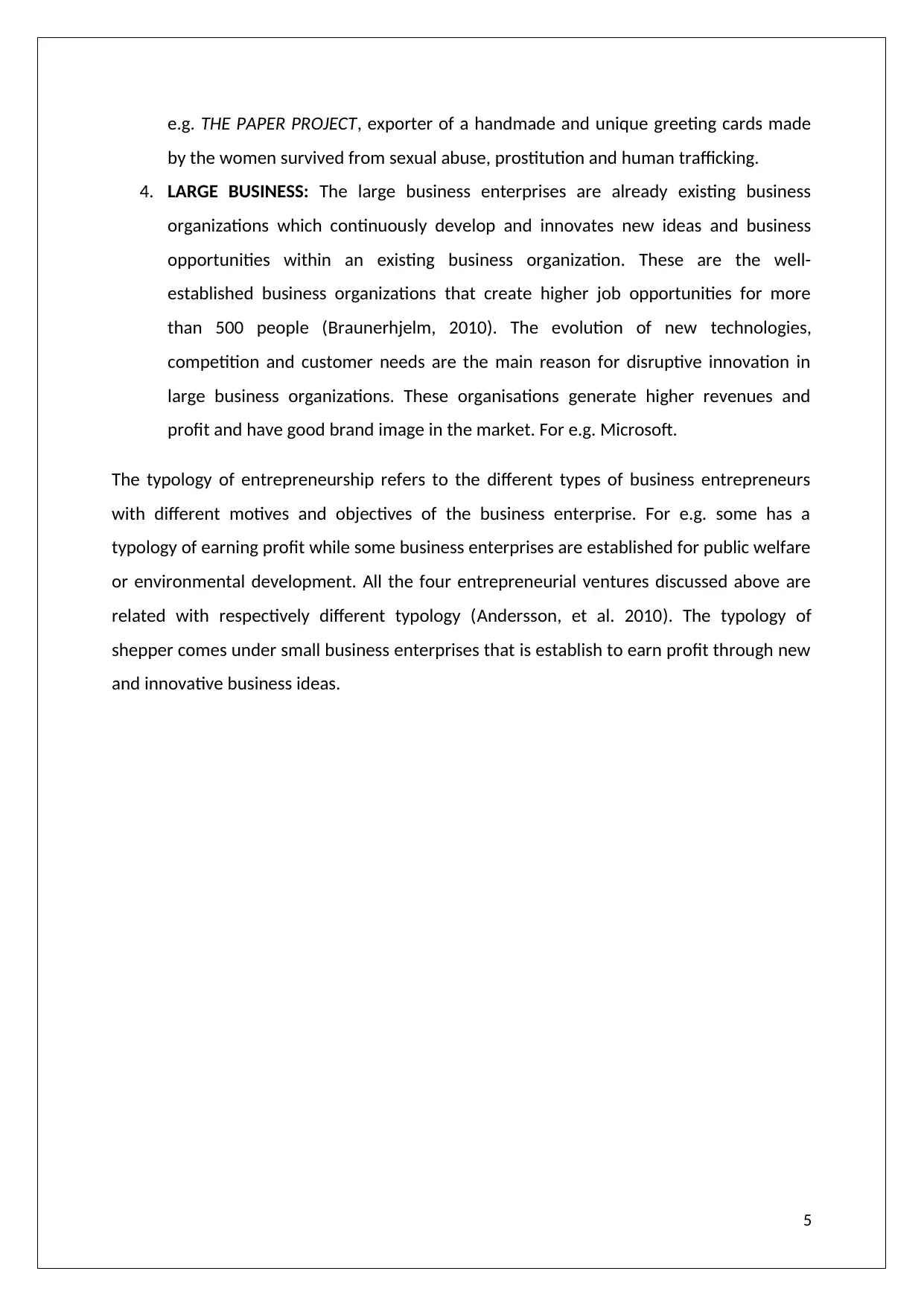
e.g. THE PAPER PROJECT, exporter of a handmade and unique greeting cards made
by the women survived from sexual abuse, prostitution and human trafficking.
4. LARGE BUSINESS: The large business enterprises are already existing business
organizations which continuously develop and innovates new ideas and business
opportunities within an existing business organization. These are the well-
established business organizations that create higher job opportunities for more
than 500 people (Braunerhjelm, 2010). The evolution of new technologies,
competition and customer needs are the main reason for disruptive innovation in
large business organizations. These organisations generate higher revenues and
profit and have good brand image in the market. For e.g. Microsoft.
The typology of entrepreneurship refers to the different types of business entrepreneurs
with different motives and objectives of the business enterprise. For e.g. some has a
typology of earning profit while some business enterprises are established for public welfare
or environmental development. All the four entrepreneurial ventures discussed above are
related with respectively different typology (Andersson, et al. 2010). The typology of
shepper comes under small business enterprises that is establish to earn profit through new
and innovative business ideas.
5
by the women survived from sexual abuse, prostitution and human trafficking.
4. LARGE BUSINESS: The large business enterprises are already existing business
organizations which continuously develop and innovates new ideas and business
opportunities within an existing business organization. These are the well-
established business organizations that create higher job opportunities for more
than 500 people (Braunerhjelm, 2010). The evolution of new technologies,
competition and customer needs are the main reason for disruptive innovation in
large business organizations. These organisations generate higher revenues and
profit and have good brand image in the market. For e.g. Microsoft.
The typology of entrepreneurship refers to the different types of business entrepreneurs
with different motives and objectives of the business enterprise. For e.g. some has a
typology of earning profit while some business enterprises are established for public welfare
or environmental development. All the four entrepreneurial ventures discussed above are
related with respectively different typology (Andersson, et al. 2010). The typology of
shepper comes under small business enterprises that is establish to earn profit through new
and innovative business ideas.
5
⊘ This is a preview!⊘
Do you want full access?
Subscribe today to unlock all pages.

Trusted by 1+ million students worldwide
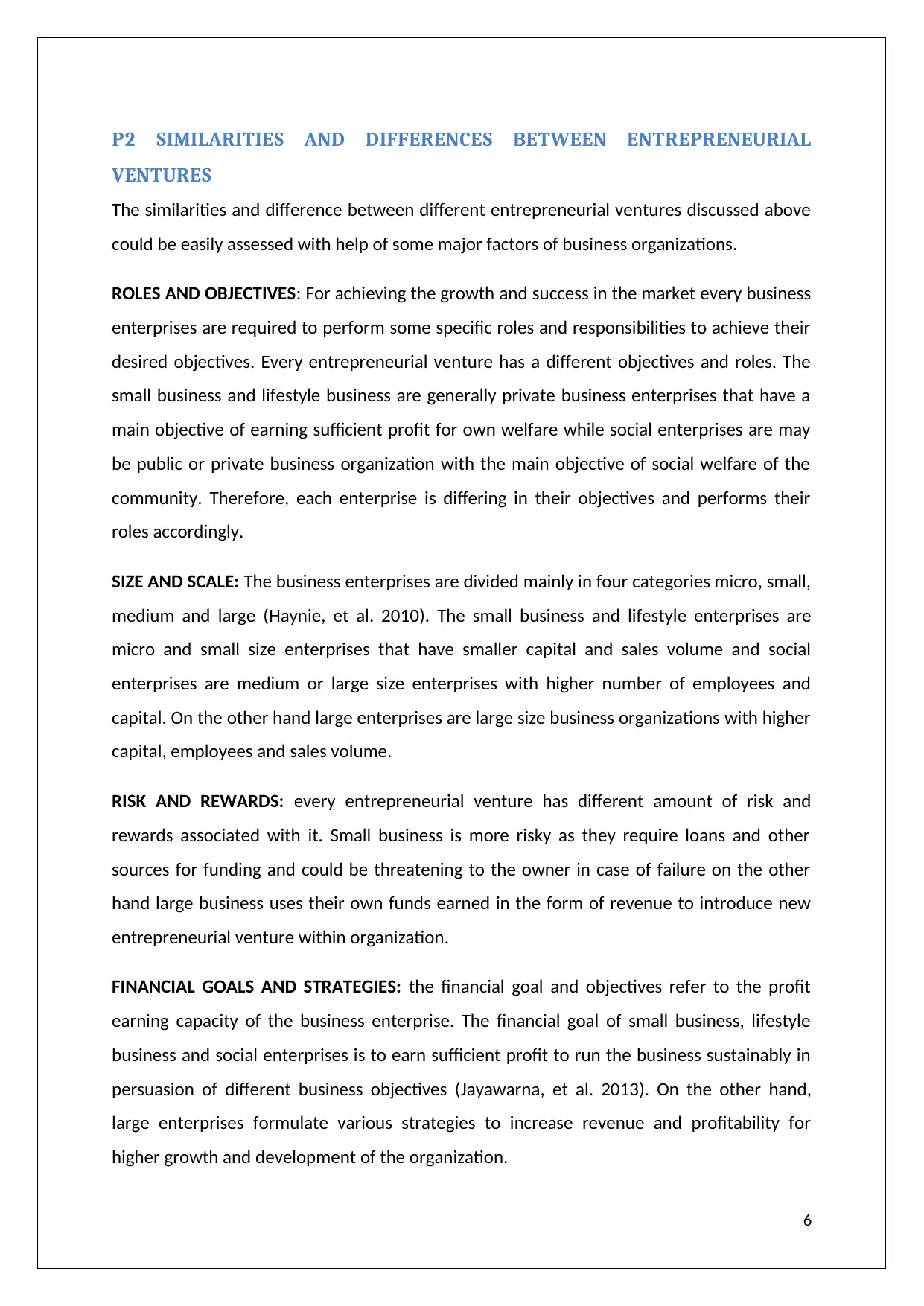
P2 SIMILARITIES AND DIFFERENCES BETWEEN ENTREPRENEURIAL
VENTURES
The similarities and difference between different entrepreneurial ventures discussed above
could be easily assessed with help of some major factors of business organizations.
ROLES AND OBJECTIVES: For achieving the growth and success in the market every business
enterprises are required to perform some specific roles and responsibilities to achieve their
desired objectives. Every entrepreneurial venture has a different objectives and roles. The
small business and lifestyle business are generally private business enterprises that have a
main objective of earning sufficient profit for own welfare while social enterprises are may
be public or private business organization with the main objective of social welfare of the
community. Therefore, each enterprise is differing in their objectives and performs their
roles accordingly.
SIZE AND SCALE: The business enterprises are divided mainly in four categories micro, small,
medium and large (Haynie, et al. 2010). The small business and lifestyle enterprises are
micro and small size enterprises that have smaller capital and sales volume and social
enterprises are medium or large size enterprises with higher number of employees and
capital. On the other hand large enterprises are large size business organizations with higher
capital, employees and sales volume.
RISK AND REWARDS: every entrepreneurial venture has different amount of risk and
rewards associated with it. Small business is more risky as they require loans and other
sources for funding and could be threatening to the owner in case of failure on the other
hand large business uses their own funds earned in the form of revenue to introduce new
entrepreneurial venture within organization.
FINANCIAL GOALS AND STRATEGIES: the financial goal and objectives refer to the profit
earning capacity of the business enterprise. The financial goal of small business, lifestyle
business and social enterprises is to earn sufficient profit to run the business sustainably in
persuasion of different business objectives (Jayawarna, et al. 2013). On the other hand,
large enterprises formulate various strategies to increase revenue and profitability for
higher growth and development of the organization.
6
VENTURES
The similarities and difference between different entrepreneurial ventures discussed above
could be easily assessed with help of some major factors of business organizations.
ROLES AND OBJECTIVES: For achieving the growth and success in the market every business
enterprises are required to perform some specific roles and responsibilities to achieve their
desired objectives. Every entrepreneurial venture has a different objectives and roles. The
small business and lifestyle business are generally private business enterprises that have a
main objective of earning sufficient profit for own welfare while social enterprises are may
be public or private business organization with the main objective of social welfare of the
community. Therefore, each enterprise is differing in their objectives and performs their
roles accordingly.
SIZE AND SCALE: The business enterprises are divided mainly in four categories micro, small,
medium and large (Haynie, et al. 2010). The small business and lifestyle enterprises are
micro and small size enterprises that have smaller capital and sales volume and social
enterprises are medium or large size enterprises with higher number of employees and
capital. On the other hand large enterprises are large size business organizations with higher
capital, employees and sales volume.
RISK AND REWARDS: every entrepreneurial venture has different amount of risk and
rewards associated with it. Small business is more risky as they require loans and other
sources for funding and could be threatening to the owner in case of failure on the other
hand large business uses their own funds earned in the form of revenue to introduce new
entrepreneurial venture within organization.
FINANCIAL GOALS AND STRATEGIES: the financial goal and objectives refer to the profit
earning capacity of the business enterprise. The financial goal of small business, lifestyle
business and social enterprises is to earn sufficient profit to run the business sustainably in
persuasion of different business objectives (Jayawarna, et al. 2013). On the other hand,
large enterprises formulate various strategies to increase revenue and profitability for
higher growth and development of the organization.
6
Paraphrase This Document
Need a fresh take? Get an instant paraphrase of this document with our AI Paraphraser

NUMBER OF EMPLOYEES: Different enterprises require varied number of employees. Small
business enterprises require maximum 1-10 employees. Lifestyle enterprises are owned by
sole person and social enterprise requires employees according to the area of operation and
activities of the organization and a large enterprise requires minimum 500 employees for its
business operations (Mauer, et al. 2017).
The above discussed factors are the main reasons for several differences and similarities in
different entrepreneurial ventures.
7
business enterprises require maximum 1-10 employees. Lifestyle enterprises are owned by
sole person and social enterprise requires employees according to the area of operation and
activities of the organization and a large enterprise requires minimum 500 employees for its
business operations (Mauer, et al. 2017).
The above discussed factors are the main reasons for several differences and similarities in
different entrepreneurial ventures.
7
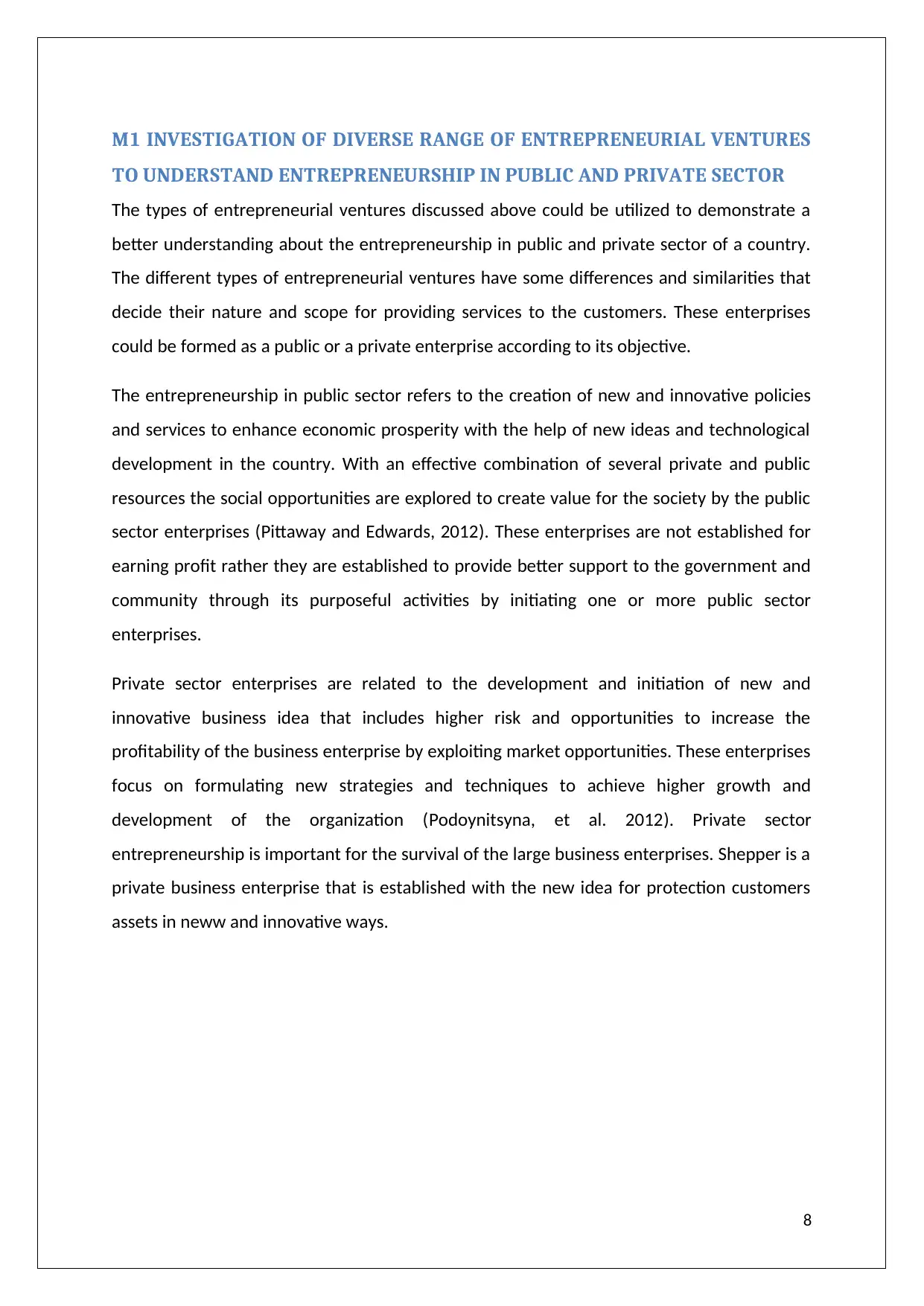
M1 INVESTIGATION OF DIVERSE RANGE OF ENTREPRENEURIAL VENTURES
TO UNDERSTAND ENTREPRENEURSHIP IN PUBLIC AND PRIVATE SECTOR
The types of entrepreneurial ventures discussed above could be utilized to demonstrate a
better understanding about the entrepreneurship in public and private sector of a country.
The different types of entrepreneurial ventures have some differences and similarities that
decide their nature and scope for providing services to the customers. These enterprises
could be formed as a public or a private enterprise according to its objective.
The entrepreneurship in public sector refers to the creation of new and innovative policies
and services to enhance economic prosperity with the help of new ideas and technological
development in the country. With an effective combination of several private and public
resources the social opportunities are explored to create value for the society by the public
sector enterprises (Pittaway and Edwards, 2012). These enterprises are not established for
earning profit rather they are established to provide better support to the government and
community through its purposeful activities by initiating one or more public sector
enterprises.
Private sector enterprises are related to the development and initiation of new and
innovative business idea that includes higher risk and opportunities to increase the
profitability of the business enterprise by exploiting market opportunities. These enterprises
focus on formulating new strategies and techniques to achieve higher growth and
development of the organization (Podoynitsyna, et al. 2012). Private sector
entrepreneurship is important for the survival of the large business enterprises. Shepper is a
private business enterprise that is established with the new idea for protection customers
assets in neww and innovative ways.
8
TO UNDERSTAND ENTREPRENEURSHIP IN PUBLIC AND PRIVATE SECTOR
The types of entrepreneurial ventures discussed above could be utilized to demonstrate a
better understanding about the entrepreneurship in public and private sector of a country.
The different types of entrepreneurial ventures have some differences and similarities that
decide their nature and scope for providing services to the customers. These enterprises
could be formed as a public or a private enterprise according to its objective.
The entrepreneurship in public sector refers to the creation of new and innovative policies
and services to enhance economic prosperity with the help of new ideas and technological
development in the country. With an effective combination of several private and public
resources the social opportunities are explored to create value for the society by the public
sector enterprises (Pittaway and Edwards, 2012). These enterprises are not established for
earning profit rather they are established to provide better support to the government and
community through its purposeful activities by initiating one or more public sector
enterprises.
Private sector enterprises are related to the development and initiation of new and
innovative business idea that includes higher risk and opportunities to increase the
profitability of the business enterprise by exploiting market opportunities. These enterprises
focus on formulating new strategies and techniques to achieve higher growth and
development of the organization (Podoynitsyna, et al. 2012). Private sector
entrepreneurship is important for the survival of the large business enterprises. Shepper is a
private business enterprise that is established with the new idea for protection customers
assets in neww and innovative ways.
8
⊘ This is a preview!⊘
Do you want full access?
Subscribe today to unlock all pages.

Trusted by 1+ million students worldwide
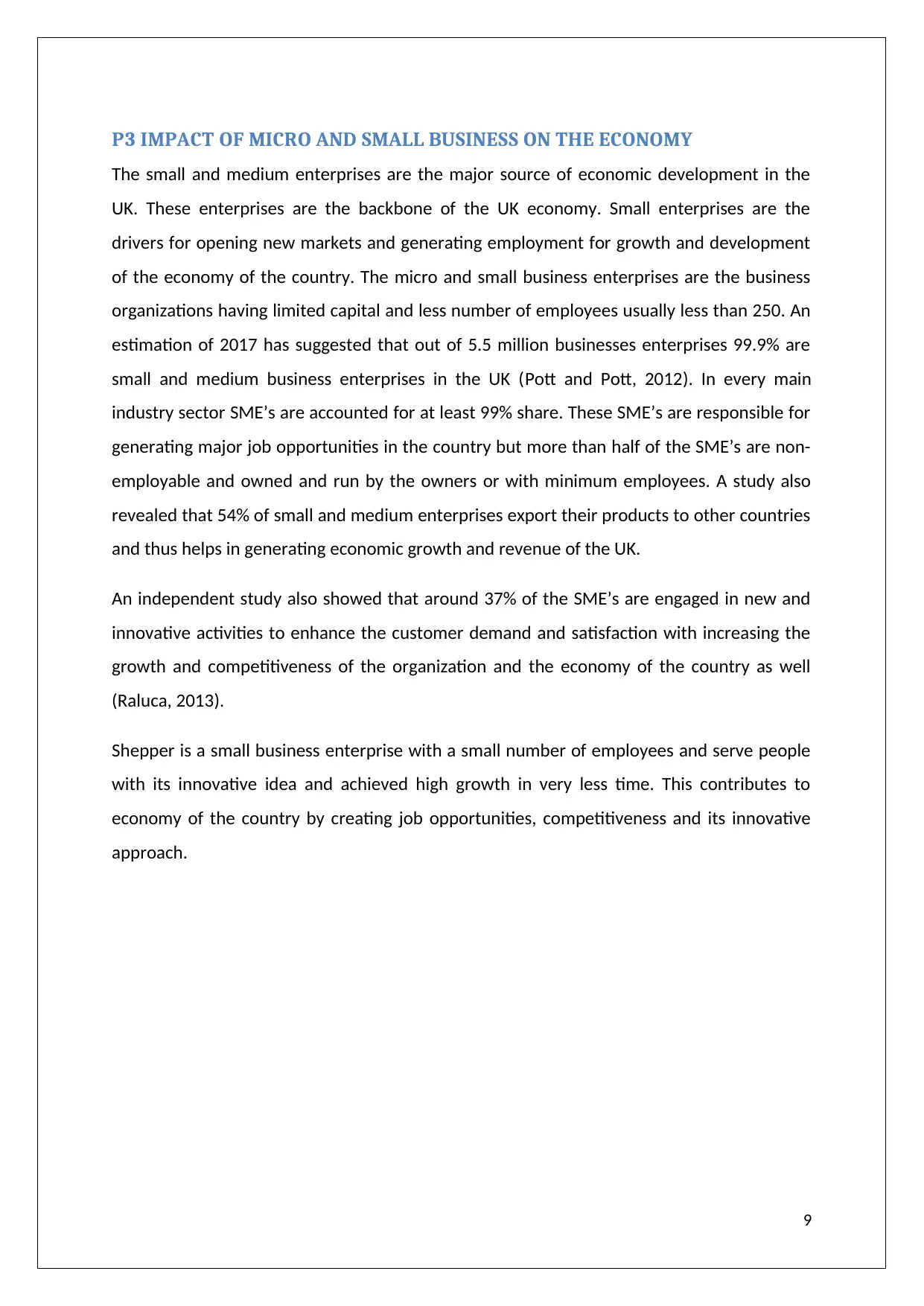
P3 IMPACT OF MICRO AND SMALL BUSINESS ON THE ECONOMY
The small and medium enterprises are the major source of economic development in the
UK. These enterprises are the backbone of the UK economy. Small enterprises are the
drivers for opening new markets and generating employment for growth and development
of the economy of the country. The micro and small business enterprises are the business
organizations having limited capital and less number of employees usually less than 250. An
estimation of 2017 has suggested that out of 5.5 million businesses enterprises 99.9% are
small and medium business enterprises in the UK (Pott and Pott, 2012). In every main
industry sector SME’s are accounted for at least 99% share. These SME’s are responsible for
generating major job opportunities in the country but more than half of the SME’s are non-
employable and owned and run by the owners or with minimum employees. A study also
revealed that 54% of small and medium enterprises export their products to other countries
and thus helps in generating economic growth and revenue of the UK.
An independent study also showed that around 37% of the SME’s are engaged in new and
innovative activities to enhance the customer demand and satisfaction with increasing the
growth and competitiveness of the organization and the economy of the country as well
(Raluca, 2013).
Shepper is a small business enterprise with a small number of employees and serve people
with its innovative idea and achieved high growth in very less time. This contributes to
economy of the country by creating job opportunities, competitiveness and its innovative
approach.
9
The small and medium enterprises are the major source of economic development in the
UK. These enterprises are the backbone of the UK economy. Small enterprises are the
drivers for opening new markets and generating employment for growth and development
of the economy of the country. The micro and small business enterprises are the business
organizations having limited capital and less number of employees usually less than 250. An
estimation of 2017 has suggested that out of 5.5 million businesses enterprises 99.9% are
small and medium business enterprises in the UK (Pott and Pott, 2012). In every main
industry sector SME’s are accounted for at least 99% share. These SME’s are responsible for
generating major job opportunities in the country but more than half of the SME’s are non-
employable and owned and run by the owners or with minimum employees. A study also
revealed that 54% of small and medium enterprises export their products to other countries
and thus helps in generating economic growth and revenue of the UK.
An independent study also showed that around 37% of the SME’s are engaged in new and
innovative activities to enhance the customer demand and satisfaction with increasing the
growth and competitiveness of the organization and the economy of the country as well
(Raluca, 2013).
Shepper is a small business enterprise with a small number of employees and serve people
with its innovative idea and achieved high growth in very less time. This contributes to
economy of the country by creating job opportunities, competitiveness and its innovative
approach.
9
Paraphrase This Document
Need a fresh take? Get an instant paraphrase of this document with our AI Paraphraser
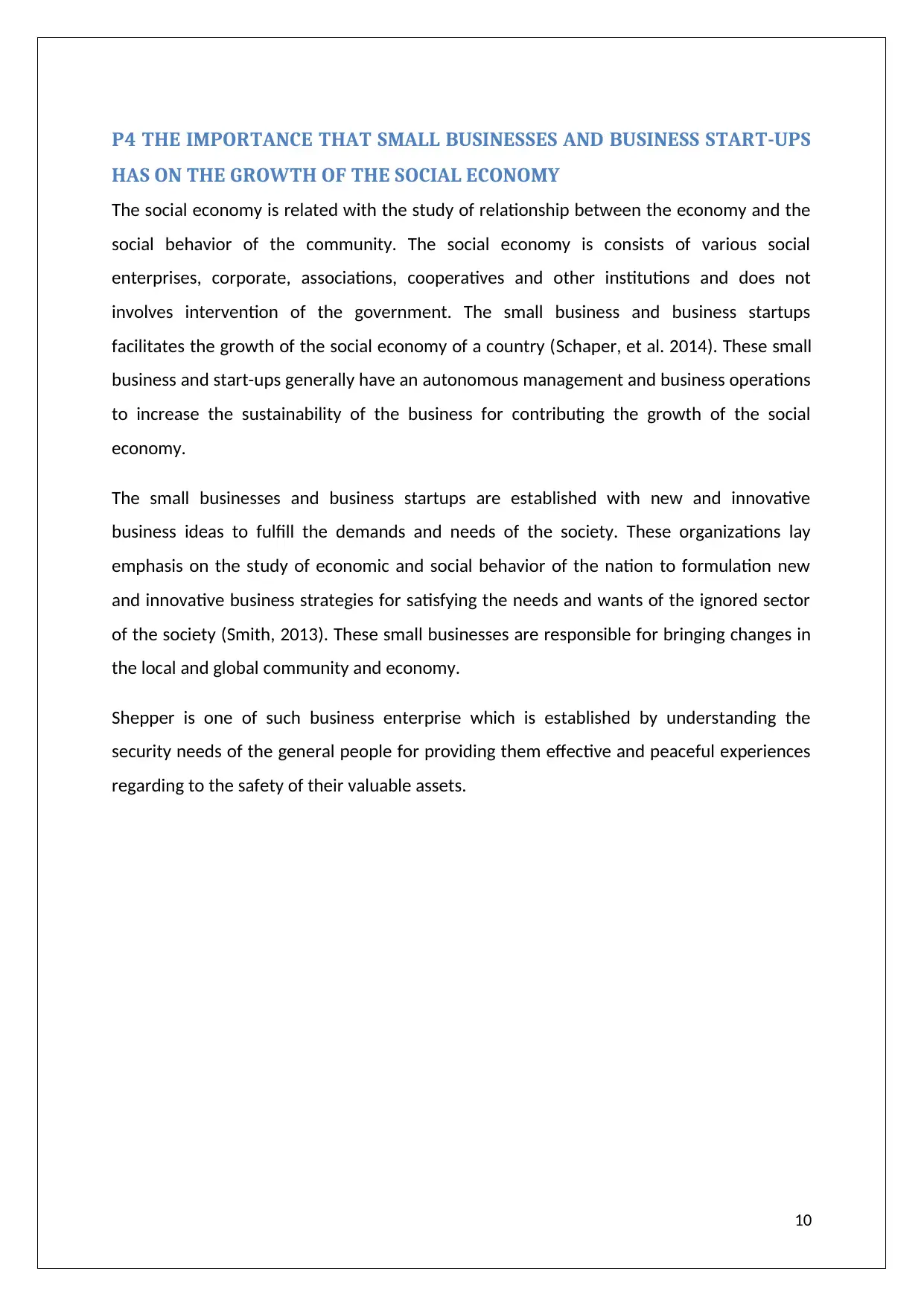
P4 THE IMPORTANCE THAT SMALL BUSINESSES AND BUSINESS START-UPS
HAS ON THE GROWTH OF THE SOCIAL ECONOMY
The social economy is related with the study of relationship between the economy and the
social behavior of the community. The social economy is consists of various social
enterprises, corporate, associations, cooperatives and other institutions and does not
involves intervention of the government. The small business and business startups
facilitates the growth of the social economy of a country (Schaper, et al. 2014). These small
business and start-ups generally have an autonomous management and business operations
to increase the sustainability of the business for contributing the growth of the social
economy.
The small businesses and business startups are established with new and innovative
business ideas to fulfill the demands and needs of the society. These organizations lay
emphasis on the study of economic and social behavior of the nation to formulation new
and innovative business strategies for satisfying the needs and wants of the ignored sector
of the society (Smith, 2013). These small businesses are responsible for bringing changes in
the local and global community and economy.
Shepper is one of such business enterprise which is established by understanding the
security needs of the general people for providing them effective and peaceful experiences
regarding to the safety of their valuable assets.
10
HAS ON THE GROWTH OF THE SOCIAL ECONOMY
The social economy is related with the study of relationship between the economy and the
social behavior of the community. The social economy is consists of various social
enterprises, corporate, associations, cooperatives and other institutions and does not
involves intervention of the government. The small business and business startups
facilitates the growth of the social economy of a country (Schaper, et al. 2014). These small
business and start-ups generally have an autonomous management and business operations
to increase the sustainability of the business for contributing the growth of the social
economy.
The small businesses and business startups are established with new and innovative
business ideas to fulfill the demands and needs of the society. These organizations lay
emphasis on the study of economic and social behavior of the nation to formulation new
and innovative business strategies for satisfying the needs and wants of the ignored sector
of the society (Smith, 2013). These small businesses are responsible for bringing changes in
the local and global community and economy.
Shepper is one of such business enterprise which is established by understanding the
security needs of the general people for providing them effective and peaceful experiences
regarding to the safety of their valuable assets.
10
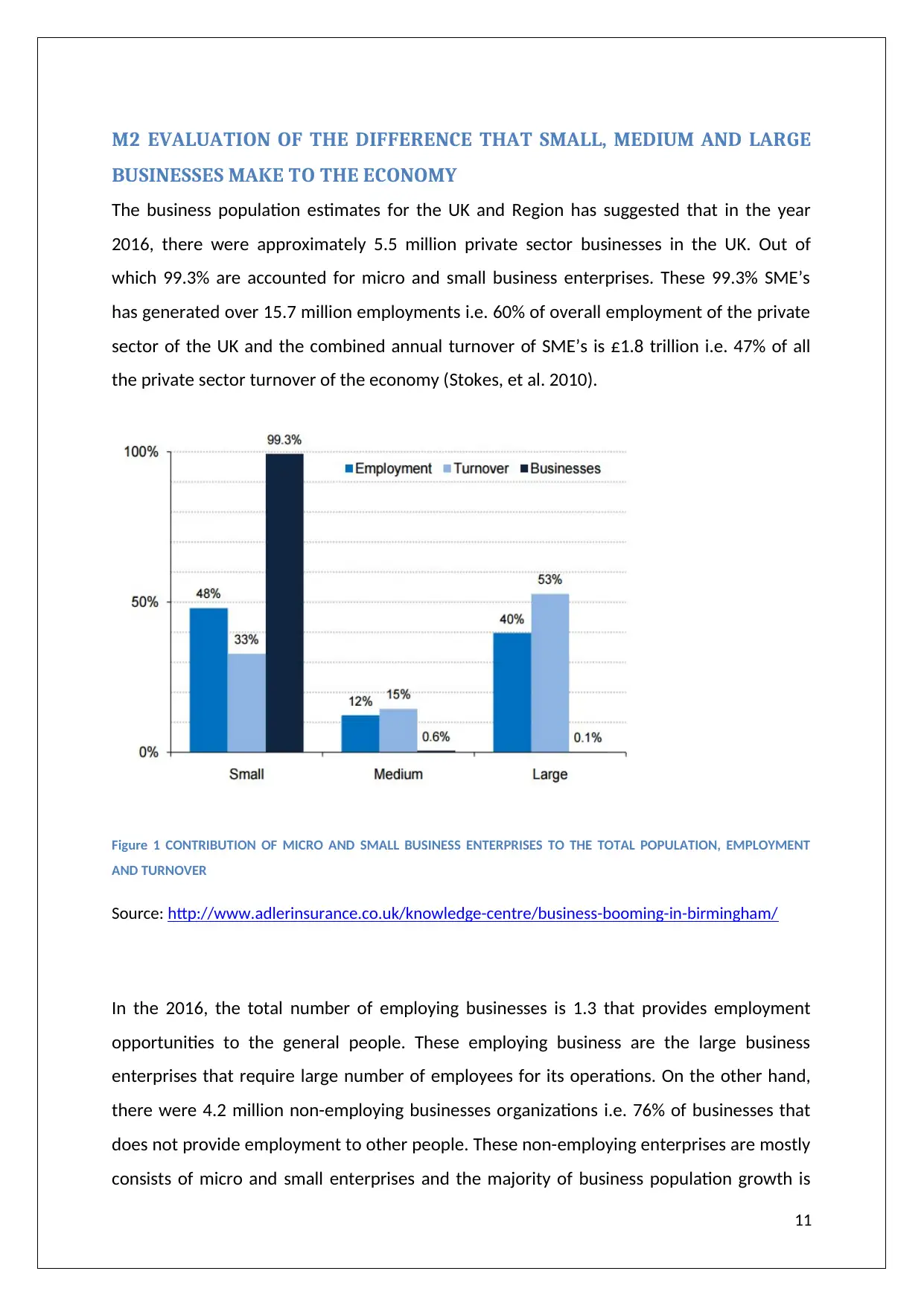
M2 EVALUATION OF THE DIFFERENCE THAT SMALL, MEDIUM AND LARGE
BUSINESSES MAKE TO THE ECONOMY
The business population estimates for the UK and Region has suggested that in the year
2016, there were approximately 5.5 million private sector businesses in the UK. Out of
which 99.3% are accounted for micro and small business enterprises. These 99.3% SME’s
has generated over 15.7 million employments i.e. 60% of overall employment of the private
sector of the UK and the combined annual turnover of SME’s is £1.8 trillion i.e. 47% of all
the private sector turnover of the economy (Stokes, et al. 2010).
Figure 1 CONTRIBUTION OF MICRO AND SMALL BUSINESS ENTERPRISES TO THE TOTAL POPULATION, EMPLOYMENT
AND TURNOVER
Source: http://www.adlerinsurance.co.uk/knowledge-centre/business-booming-in-birmingham/
In the 2016, the total number of employing businesses is 1.3 that provides employment
opportunities to the general people. These employing business are the large business
enterprises that require large number of employees for its operations. On the other hand,
there were 4.2 million non-employing businesses organizations i.e. 76% of businesses that
does not provide employment to other people. These non-employing enterprises are mostly
consists of micro and small enterprises and the majority of business population growth is
11
BUSINESSES MAKE TO THE ECONOMY
The business population estimates for the UK and Region has suggested that in the year
2016, there were approximately 5.5 million private sector businesses in the UK. Out of
which 99.3% are accounted for micro and small business enterprises. These 99.3% SME’s
has generated over 15.7 million employments i.e. 60% of overall employment of the private
sector of the UK and the combined annual turnover of SME’s is £1.8 trillion i.e. 47% of all
the private sector turnover of the economy (Stokes, et al. 2010).
Figure 1 CONTRIBUTION OF MICRO AND SMALL BUSINESS ENTERPRISES TO THE TOTAL POPULATION, EMPLOYMENT
AND TURNOVER
Source: http://www.adlerinsurance.co.uk/knowledge-centre/business-booming-in-birmingham/
In the 2016, the total number of employing businesses is 1.3 that provides employment
opportunities to the general people. These employing business are the large business
enterprises that require large number of employees for its operations. On the other hand,
there were 4.2 million non-employing businesses organizations i.e. 76% of businesses that
does not provide employment to other people. These non-employing enterprises are mostly
consists of micro and small enterprises and the majority of business population growth is
11
⊘ This is a preview!⊘
Do you want full access?
Subscribe today to unlock all pages.

Trusted by 1+ million students worldwide
1 out of 24
Related Documents
Your All-in-One AI-Powered Toolkit for Academic Success.
+13062052269
info@desklib.com
Available 24*7 on WhatsApp / Email
![[object Object]](/_next/static/media/star-bottom.7253800d.svg)
Unlock your academic potential
Copyright © 2020–2025 A2Z Services. All Rights Reserved. Developed and managed by ZUCOL.





